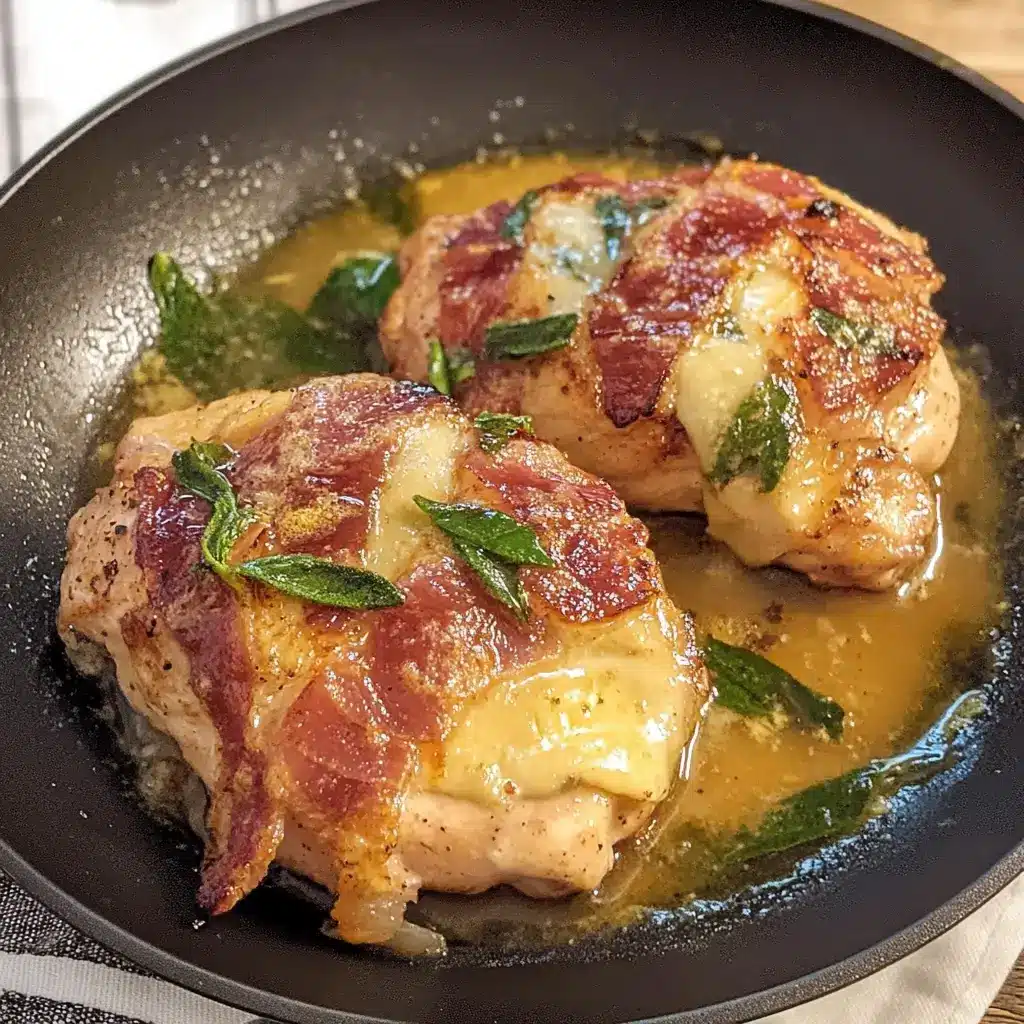Chicken Saltimbocca. Just the name rolls off the tongue with a hint of Italian charm, doesn’t it? For years, I’d seen this dish mentioned in cookbooks and on cooking shows, always intrigued by its elegant simplicity. Then, a few months ago, on a whim (and with a craving for something beyond our usual weeknight rotation), I decided to finally try making it. Let me tell you, it was a revelation. From the first sizzle of butter in the pan to the final, savory bite, this dish completely captivated my family. The tender chicken, fragrant sage, salty prosciutto, and the delicate white wine sauce – it’s a symphony of flavors that somehow manages to be both sophisticated and incredibly comforting. My kids, who are usually picky eaters, devoured it, proclaiming it their new favorite chicken dish. My husband, a self-proclaimed meat and potatoes man, was equally impressed. Since that first attempt, Chicken Saltimbocca has become a regular feature on our dinner table. It’s surprisingly quick and easy to prepare, making it perfect for busy weeknights, yet it’s impressive enough to serve to guests. If you’re looking for a dish that’s guaranteed to impress with minimal effort and maximum flavor, look no further. This Chicken Saltimbocca recipe is a winner, and I’m excited to share it with you. Get ready to transport your kitchen (and your taste buds) straight to Italy!
Ingredients
To create this classic Italian dish, you’ll need a handful of high-quality ingredients. The beauty of Saltimbocca lies in its simplicity, so each component plays a crucial role in the final flavor profile. Here’s what you’ll need:
- Chicken Breasts: 4 boneless, skinless chicken breasts, about 6-8 ounces each. Opt for breasts that are of uniform thickness for even cooking. If your breasts are very thick, you’ll want to butterfly them or pound them thinner.
- Prosciutto: 8 thin slices of prosciutto. Prosciutto adds a salty, savory depth that is essential to Saltimbocca. Look for good quality prosciutto, as the flavor will really shine through. Avoid pre-shredded or diced prosciutto, as you want thin, intact slices.
- Fresh Sage Leaves: 8-12 fresh sage leaves. Sage provides a distinctively earthy and slightly peppery aroma that complements the chicken and prosciutto beautifully. Fresh sage is crucial here; dried sage won’t deliver the same bright, aromatic flavor.
- All-Purpose Flour: 1/4 cup, for dredging (optional). A light dusting of flour helps to create a slightly golden crust on the chicken and aids in thickening the sauce. If you prefer a gluten-free version or want to skip the flour, you can omit it.
- Dry White Wine: 1/2 cup. A dry white wine like Pinot Grigio, Sauvignon Blanc, or dry Vermouth adds acidity and complexity to the sauce. Choose a wine you would enjoy drinking, as its flavor will be prominent in the dish. Chicken broth can be substituted if you prefer to avoid alcohol, but the wine adds a characteristic depth of flavor.
- Butter: 4 tablespoons, unsalted. Butter contributes richness and flavor to both the chicken and the sauce. Unsalted butter allows you to control the saltiness of the dish, especially considering the prosciutto is already quite salty.
- Olive Oil: 2 tablespoons, extra virgin. Olive oil is used for searing the chicken and adds a fruity, subtle peppery note. Extra virgin olive oil is preferred for its flavor and health benefits.
- Salt: To taste. Be mindful of the saltiness of the prosciutto when seasoning. You may need less salt than you typically use.
- Black Pepper: Freshly ground, to taste. Freshly ground black pepper adds a more vibrant and aromatic pepper flavor compared to pre-ground pepper.
Instructions
Making Chicken Saltimbocca is surprisingly straightforward. Follow these step-by-step instructions to create a restaurant-worthy dish in your own kitchen:
- Prepare the Chicken: Place each chicken breast between two sheets of plastic wrap or parchment paper. Using a meat mallet or the bottom of a heavy skillet, gently pound the chicken breasts to an even thickness of about 1/4-inch to 1/2-inch. This ensures even cooking and tenderizes the chicken. Be careful not to pound them too thin, or they will become dry.
- Season and Assemble: Lightly season both sides of the pounded chicken breasts with salt and freshly ground black pepper. Remember that prosciutto is salty, so season cautiously. Place 1-2 fresh sage leaves on top of each chicken breast. Drape a slice of prosciutto over the sage leaves, ensuring it covers most of the chicken breast surface. Secure the prosciutto and sage to the chicken by gently pressing down. You can use toothpicks to secure them if needed, especially if the prosciutto is not sticking well, but often, gentle pressing is sufficient.
- Dredge in Flour (Optional): If using flour, lightly dredge the prosciutto-side of each chicken breast in all-purpose flour, shaking off any excess. This creates a light coating that will help the chicken brown and the sauce thicken slightly.
- Sear the Chicken: Heat olive oil and 2 tablespoons of butter in a large skillet over medium-high heat. Once the butter is melted and the pan is hot (but not smoking), carefully place the chicken breasts in the skillet, prosciutto-side down. Sear for 3-4 minutes, or until the prosciutto is crispy and golden brown and the chicken is nicely browned. Avoid overcrowding the pan; work in batches if necessary to ensure proper browning.
- Flip and Cook Through: Using tongs, carefully flip the chicken breasts over to the other side. Cook for another 3-5 minutes, or until the chicken is cooked through and no longer pink in the center. The internal temperature should reach 165°F (74°C). Avoid overcooking, as chicken breasts can become dry.
- Remove Chicken and Deglaze: Remove the cooked chicken breasts from the skillet and set aside on a plate, keeping them warm. Reduce the heat to medium. Add the remaining 2 tablespoons of butter to the skillet. Once melted, pour in the dry white wine (or chicken broth). Using a wooden spoon or spatula, scrape up any browned bits from the bottom of the pan (these are called “fond” and are packed with flavor). This process is called deglazing, and it creates the base for your sauce.
- Simmer the Sauce: Bring the wine sauce to a simmer and let it reduce slightly for 2-3 minutes, or until it thickens slightly. Taste the sauce and adjust seasoning with salt and pepper if needed. The sauce should be light and flavorful, not overly thick.
- Return Chicken and Serve: Return the cooked chicken breasts to the skillet with the sauce. Spoon the sauce over the chicken to coat. Heat through for another minute or two to ensure the chicken is warmed and coated in the sauce.
- Serve Immediately: Chicken Saltimbocca is best served immediately while it’s hot and the prosciutto is crispy. Garnish with extra fresh sage leaves, if desired. Serve over pasta, polenta, mashed potatoes, or alongside roasted vegetables for a complete and satisfying meal.
Nutrition Facts
(Estimated per serving, assuming 4 servings)
Please note that these are approximate values and can vary based on specific ingredients, portion sizes, and cooking methods. For more precise nutritional information, you can use a nutrition calculator with the specific brands and quantities of ingredients you use.
- Servings: 4
- Calories per Serving: Approximately 450-550 calories
Breakdown (Approximate):
- Protein: 45-55 grams
- Fat: 25-35 grams
- Saturated Fat: 10-15 grams
- Cholesterol: 150-200 mg
- Sodium: 700-900 mg (varies greatly depending on prosciutto and salt added)
- Carbohydrates: 5-10 grams (primarily from flour, if used, and wine)
- Fiber: Less than 1 gram
- Sugar: Less than 2 grams
Important Considerations:
- Sodium Content: Prosciutto is naturally high in sodium. Be mindful of added salt and adjust seasoning accordingly. Individuals watching their sodium intake should be aware of this.
- Fat Content: While the fat content is moderate, it’s important to consider the type of fat. Olive oil and some fats from prosciutto are considered healthier fats.
- Calorie Range: The calorie range can fluctuate based on portion size and added ingredients. Serving with lighter sides like steamed vegetables will help keep the overall meal calorie-conscious.
This dish is a good source of lean protein and provides some essential nutrients. Enjoy it in moderation as part of a balanced diet.
Preparation Time
Chicken Saltimbocca is a relatively quick and easy dish to prepare, making it ideal for weeknight dinners or when you need an impressive meal in a short amount of time.
- Prep Time: 15-20 minutes (This includes pounding the chicken, assembling with prosciutto and sage, and gathering ingredients.)
- Cook Time: 15-20 minutes (This includes searing the chicken and making the sauce.)
- Total Time: Approximately 30-40 minutes
This timeframe can vary slightly depending on your knife skills and familiarity with the recipe. However, even for a beginner cook, Chicken Saltimbocca is achievable within this time frame. The quick cooking time makes it a great option when you want a delicious and flavorful meal without spending hours in the kitchen.
How to Serve Chicken Saltimbocca
Chicken Saltimbocca is a versatile dish that pairs well with a variety of sides. Here are some serving suggestions to create a complete and satisfying meal:
Classic Italian Pairings:
- Pasta: Serve over a bed of linguine, spaghetti, or fettuccine tossed with a light olive oil and garlic sauce, or simply butter and Parmesan cheese. The sauce from the Saltimbocca will beautifully coat the pasta.
- Risotto: Creamy risotto, especially a simple Parmesan risotto or a lemon risotto, complements the richness of the chicken and sauce.
- Polenta: Soft and creamy polenta provides a comforting base for the Saltimbocca and soaks up the delicious white wine sauce.
Vegetable Sides:
- Roasted Vegetables: Roasted asparagus, broccoli, green beans, or bell peppers are excellent choices. Roasting brings out the natural sweetness of vegetables and provides a healthy counterpoint to the richness of the chicken.
- Sautéed Spinach or Garlic Greens: A simple side of sautéed spinach or other leafy greens with garlic and olive oil adds freshness and nutrients.
- Caprese Salad: A classic Caprese salad with fresh tomatoes, mozzarella, and basil provides a light and refreshing starter or side that complements the Italian flavors of the Saltimbocca.
Starchy Sides:
- Mashed Potatoes: Creamy mashed potatoes are a comforting and satisfying side that works well with the sauce.
- Roasted Potatoes: Roasted potatoes, seasoned with herbs like rosemary or thyme, offer a heartier side dish.
Wine Pairings:
- White Wine: Continue with the dry white wine used in the recipe, such as Pinot Grigio, Sauvignon Blanc, or Vermentino. These wines are crisp and acidic, complementing the richness of the dish.
- Light-Bodied Red Wine: For red wine lovers, a light-bodied red like Pinot Noir or a fruity Italian red like Chianti Classico can also pair nicely.
Serving Occasions:
- Weeknight Dinner: Quick and easy enough for a flavorful weeknight meal.
- Family Gatherings: A crowd-pleasing dish that’s sure to be enjoyed by all ages.
- Dinner Parties: Elegant and impressive enough to serve to guests, yet simple to prepare.
- Special Occasions: Elevate your special occasion meal with this classic Italian dish.
No matter how you choose to serve it, Chicken Saltimbocca is a dish that’s sure to impress. The combination of flavors and textures makes it a truly delightful culinary experience.
Additional Tips for Perfect Chicken Saltimbocca
To ensure your Chicken Saltimbocca is a success every time, here are five helpful tips:
- Use High-Quality Ingredients: Since Saltimbocca is a simple dish with few ingredients, the quality of each ingredient really matters. Use good quality prosciutto, fresh sage, and a dry white wine you enjoy drinking. Fresh, plump chicken breasts will also make a difference in the final texture and flavor.
- Don’t Overcook the Chicken: Chicken breasts can become dry if overcooked. Pound the chicken to an even thickness to ensure it cooks quickly and evenly. Cook just until it reaches an internal temperature of 165°F (74°C). The residual heat will continue to cook it slightly after removing it from the pan.
- Crisp Prosciutto is Key: The crispy prosciutto is a defining characteristic of Saltimbocca. Ensure you sear the chicken prosciutto-side down first and cook it until the prosciutto is golden brown and crispy. This adds a wonderful salty, savory crunch to the dish.
- Don’t Overcrowd the Pan: Overcrowding the pan will lower the temperature and prevent the chicken from browning properly. Cook the chicken in batches if necessary to ensure each piece has enough space to sear and crisp up.
- Make the Sauce Just Before Serving: The white wine sauce is best when made fresh and served immediately. It reduces quickly and is at its peak flavor right after cooking. If you need to make it ahead, you can keep it warm on very low heat, but it’s best to prepare it while the chicken is resting or just before serving.
Frequently Asked Questions (FAQ)
Here are some common questions about making Chicken Saltimbocca:
Q1: Can I use chicken thighs instead of chicken breasts?
A: While traditionally made with chicken breasts, you can use boneless, skinless chicken thighs for a richer flavor and more forgiving texture. Thighs tend to stay moister than breasts. You may need to adjust the cooking time slightly, ensuring the thighs are cooked through to an internal temperature of 165°F (74°C).
Q2: I don’t have prosciutto. Can I substitute it with something else?
A: Prosciutto is a key ingredient in Saltimbocca, contributing a unique salty and savory flavor. While there isn’t a perfect substitute, you could try using thinly sliced Serrano ham or even good quality cooked ham as a less authentic but still flavorful alternative. However, the taste will be slightly different. Pancetta, while also Italian and salty, is often too thick and fatty to be a direct substitute in this recipe.
Q3: Can I make Chicken Saltimbocca ahead of time?
A: Chicken Saltimbocca is best served immediately for optimal crispiness of the prosciutto and tenderness of the chicken. While you can prepare the chicken breasts by pounding them and attaching the prosciutto and sage ahead of time (up to a few hours), it’s best to cook and sauce the dish just before serving. Reheating cooked Saltimbocca can make the prosciutto lose its crispness and the chicken can become drier.
Q4: Can I make a larger batch of the sauce?
A: Yes, you can easily double or triple the sauce recipe if you are serving a larger crowd or prefer extra sauce. Simply adjust the amount of white wine and butter proportionally.
Q5: What if I don’t drink wine? Can I still make the sauce?
A: Absolutely! You can substitute chicken broth or stock for the dry white wine in the sauce. While the white wine adds a characteristic acidity and depth of flavor, chicken broth will still create a delicious and flavorful sauce. You might consider adding a squeeze of lemon juice at the end to mimic some of the acidity from the wine.
Chicken Saltimbocca is a truly delightful dish that’s easier to make than it seems. With a few simple steps and quality ingredients, you can bring a taste of Italy to your own table and impress your family and friends. Buon Appetito!
Print
Chicken Saltimbocca Recipe
Ingredients
- Chicken Breasts: 4 boneless, skinless chicken breasts, about 6-8 ounces each. Opt for breasts that are of uniform thickness for even cooking. If your breasts are very thick, you’ll want to butterfly them or pound them thinner.
- Prosciutto: 8 thin slices of prosciutto. Prosciutto adds a salty, savory depth that is essential to Saltimbocca. Look for good quality prosciutto, as the flavor will really shine through. Avoid pre-shredded or diced prosciutto, as you want thin, intact slices.
- Fresh Sage Leaves: 8-12 fresh sage leaves. Sage provides a distinctively earthy and slightly peppery aroma that complements the chicken and prosciutto beautifully. Fresh sage is crucial here; dried sage won’t deliver the same bright, aromatic flavor.
- All-Purpose Flour: 1/4 cup, for dredging (optional). A light dusting of flour helps to create a slightly golden crust on the chicken and aids in thickening the sauce. If you prefer a gluten-free version or want to skip the flour, you can omit it.
- Dry White Wine: 1/2 cup. A dry white wine like Pinot Grigio, Sauvignon Blanc, or dry Vermouth adds acidity and complexity to the sauce. Choose a wine you would enjoy drinking, as its flavor will be prominent in the dish. Chicken broth can be substituted if you prefer to avoid alcohol, but the wine adds a characteristic depth of flavor.
- Butter: 4 tablespoons, unsalted. Butter contributes richness and flavor to both the chicken and the sauce. Unsalted butter allows you to control the saltiness of the dish, especially considering the prosciutto is already quite salty.
- Olive Oil: 2 tablespoons, extra virgin. Olive oil is used for searing the chicken and adds a fruity, subtle peppery note. Extra virgin olive oil is preferred for its flavor and health benefits.
- Salt: To taste. Be mindful of the saltiness of the prosciutto when seasoning. You may need less salt than you typically use.
- Black Pepper: Freshly ground, to taste. Freshly ground black pepper adds a more vibrant and aromatic pepper flavor compared to pre-ground pepper.
Instructions
- Prepare the Chicken: Place each chicken breast between two sheets of plastic wrap or parchment paper. Using a meat mallet or the bottom of a heavy skillet, gently pound the chicken breasts to an even thickness of about 1/4-inch to 1/2-inch. This ensures even cooking and tenderizes the chicken. Be careful not to pound them too thin, or they will become dry.
- Season and Assemble: Lightly season both sides of the pounded chicken breasts with salt and freshly ground black pepper. Remember that prosciutto is salty, so season cautiously. Place 1-2 fresh sage leaves on top of each chicken breast. Drape a slice of prosciutto over the sage leaves, ensuring it covers most of the chicken breast surface. Secure the prosciutto and sage to the chicken by gently pressing down. You can use toothpicks to secure them if needed, especially if the prosciutto is not sticking well, but often, gentle pressing is sufficient.
- Dredge in Flour (Optional): If using flour, lightly dredge the prosciutto-side of each chicken breast in all-purpose flour, shaking off any excess. This creates a light coating that will help the chicken brown and the sauce thicken slightly.
- Sear the Chicken: Heat olive oil and 2 tablespoons of butter in a large skillet over medium-high heat. Once the butter is melted and the pan is hot (but not smoking), carefully place the chicken breasts in the skillet, prosciutto-side down. Sear for 3-4 minutes, or until the prosciutto is crispy and golden brown and the chicken is nicely browned. Avoid overcrowding the pan; work in batches if necessary to ensure proper browning.
- Flip and Cook Through: Using tongs, carefully flip the chicken breasts over to the other side. Cook for another 3-5 minutes, or until the chicken is cooked through and no longer pink in the center. The internal temperature should reach 165°F (74°C). Avoid overcooking, as chicken breasts can become dry.
- Remove Chicken and Deglaze: Remove the cooked chicken breasts from the skillet and set aside on a plate, keeping them warm. Reduce the heat to medium. Add the remaining 2 tablespoons of butter to the skillet. Once melted, pour in the dry white wine (or chicken broth). Using a wooden spoon or spatula, scrape up any browned bits from the bottom of the pan (these are called “fond” and are packed with flavor). This process is called deglazing, and it creates the base for your sauce.
- Simmer the Sauce: Bring the wine sauce to a simmer and let it reduce slightly for 2-3 minutes, or until it thickens slightly. Taste the sauce and adjust seasoning with salt and pepper if needed. The sauce should be light and flavorful, not overly thick.
- Return Chicken and Serve: Return the cooked chicken breasts to the skillet with the sauce. Spoon the sauce over the chicken to coat. Heat through for another minute or two to ensure the chicken is warmed and coated in the sauce.
- Serve Immediately: Chicken Saltimbocca is best served immediately while it’s hot and the prosciutto is crispy. Garnish with extra fresh sage leaves, if desired. Serve over pasta, polenta, mashed potatoes, or alongside roasted vegetables for a complete and satisfying meal.
Nutrition
- Serving Size: One Normal Portion
- Calories: 450-550
- Sugar: Less than 2 grams
- Sodium: 700-900 mg
- Fat: 25-35 grams
- Saturated Fat: 10-15 grams
- Carbohydrates: 5-10 grams
- Fiber: Less than 1 gram
- Protein: 45-55 grams
- Cholesterol: 150-200 mg





